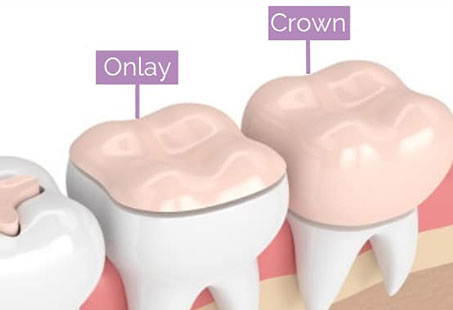Amelia Grant
Dental Crowns vs Onlays: What to Choose

Dental restorations can help restore a tooth's natural appearance by treating decay (cavities), cracks, and other problems.
There is no one restoration option. Crowns and onlays, for example, perform comparable functions. However, unlike a dental crown, which completely covers the surface of a tooth, an onlay (or partial crown) just covers a portion of a tooth.
Here's everything you should know about crowns and onlays, including how they differ, their advantages and disadvantages, and how to work with a dentist to determine which is best for you.
How do a crown and an onlay compare?
Minor cavities and damage can be treated with dental fillings. However, certain cavities and damage are too severe for a filling. In this scenario, a crown or onlay may be required to repair the tooth.
Dental onlays are used to treat damage on the cusp, which is the elevated section of the tooth surface. These are constructed of porcelain or gold and cover only the affected portion of the tooth.
If you have a severely damaged or rotting tooth, you may require a dental crown that covers the entire tooth.
Crowns are used to repair a badly worn or fractured tooth. Covering the entire tooth can prevent additional damage and save the tooth.
Dental crowns can also be composed of porcelain or gold.
Pros and cons of a crown vs. an onlay
The extent of the damage and the state of your teeth determine whether you get a dental crown or a dental onlay.
However, before deciding on one or the other, it is critical to grasp the benefits and drawbacks of both restorative therapies.
Here's a guide to weighing the advantages and disadvantages of getting a dental crown or onlay.
Dental Crown
Pros
- Material that is long-lasting (similar to onlays).
- Large or worn fillings are repaired.
- Prevents further harm to damaged or decaying teeth.
- Restores a tooth's natural appearance.
- It can be used to reshape a tooth.
- Keeps a tooth's integrity following a root canal.
Cons
- A more involved operation than a dental onlay.
- Dental crowns can chip or break, necessitating additional treatment.
- A dental onlay is less expensive.
- Following a procedure, you may experience sensitivity to heat or cold.
- The substance may cause an allergic reaction.
- More than one appointment is required.
Dental Onlay
Pros
- Material that is long-lasting (similar to a crown).
- Repairs and reshapes broken teeth
- Reduces the possibility of future deterioration.
- Restores the natural appearance of the teeth.
- A more conservative procedure with less thorough preparation that protects more of your tooth structure.
- It's less expensive than a dental crown.
Cons
- Can be less expensive than or comparable to a crown.
- Can chip or crack, necessitating additional repair.
- Following a procedure, you may experience sensitivity to heat or cold.
- The substance may cause an allergic reaction.
- More than one appointment is required.
- It may be more difficult to execute.
How does the cost compare for a crown vs. an onlay?
Treatment expenses vary by kind but generally fall between the following ranges:
- onlay: $650 to $1,200 per tooth
- crown: $500 to $3,000 per tooth
Other cost-determining elements include:
- the tooth's position in your mouth
- how much does the required tooth repair cost
- other operations, in addition to the repair, may be required
- when it is an emergency service or a non-emergency operation
- the material utilized – for example, metal is frequently less expensive than porcelain
- Insurance coverage – most dental plans cover a portion of the cost of a crown or onlay (up to 50%)
- using an in-network or out-of-network provider – Seeing a dentist outside of your insurance carrier's network will cost you extra money out of cash
If you don't have dental insurance, you'll be on the hook for the entire bill. Some dentists provide payment options in this situation. You could potentially be eligible for dental financial help programs.
How long does a crown or an onlay last?
Dental crowns and onlays are built to last between 5 and 15 years.
However, certain factors may limit its duration, such as:
- injury to the tooth or surrounding area
- biting your nails
- grinding your teeth
- chewing hard or sticky objects
These can cause the material to break, crack, or chip, necessitating immediate repair or replacement.
